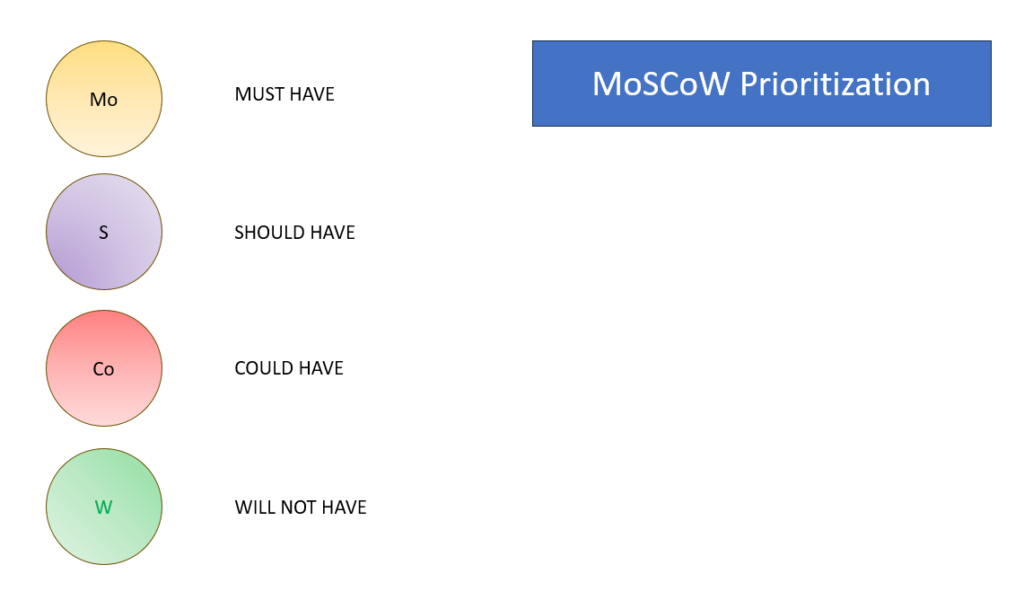In the ever-evolving world of project management and software development, effective prioritization is crucial for success. With multiple stakeholders, limited resources, and tight deadlines, determining what tasks and features to focus on can be a daunting challenge. Enter the MoSCoW method—a straightforward yet powerful prioritization technique that helps teams and organizations identify what truly matters. Named after its categories: Must Have, Should Have, Could Have, and Won’t Have, the MoSCoW method provides a clear framework for making informed decisions and ensuring that critical requirements are met without overloading the team.
The MoSCoW method was developed by Dai Clegg while working at Oracle and later popularized by the Dynamic Systems Development Method (DSDM) consortium. It addresses a common problem in project management: the tendency to treat all requirements as equally important, leading to scope creep, missed deadlines, and compromised quality. By categorizing requirements into distinct groups, MoSCoW allows teams to focus on what is essential for project success and deliver a product that meets user needs and expectations.
Contents
Prioritizing Effectively: The MoSCoW Method explained. 1
Understanding the MoSCoW Method. 1
The Four Categories of MoSCoW.. 1
Practical Examples of the MoSCoW Method. 2
Example 1: Software Development Project 2
Benefits of the MoSCoW Method. 4
Potential Pitfalls and How to Avoid Them.. 4
Best Practices for Implementing the MoSCoW Method. 5
At its core, the MoSCoW method is about communication and consensus. It requires collaboration among stakeholders to agree on what is truly necessary and what can be deferred or excluded. This consensus-building process not only clarifies priorities but also aligns the team around common goals, fostering a shared understanding of project objectives. By providing a transparent and structured approach to prioritization, the MoSCoW method helps manage expectations and reduces the risk of disputes and misunderstandings.
In this comprehensive guide, we will delve into the intricacies of the MoSCoW method, exploring each of its categories in detail. We will provide practical examples to illustrate how the method can be applied in various contexts, from software development to event planning. Additionally, we will discuss the benefits and potential pitfalls of the MoSCoW method, offering tips and best practices for maximizing its effectiveness. Whether you are a project manager, product owner, or team member, understanding and utilizing the MoSCoW method can enhance your ability to prioritize effectively and deliver successful projects.
Understanding the MoSCoW Method

The Four Categories of MoSCoW
- Must Have:
- These are the non-negotiable requirements that are essential for the project’s success.
- Failure to deliver these requirements means the project is considered a failure.
- Examples include core functionality in software, legal and regulatory compliance, and critical safety features.
- Should Have:
- Important but not vital requirements.
- These requirements add significant value but can be deferred if necessary.
- Examples include enhanced user experience features, performance improvements, and additional security measures.
- Could Have:
- Desirable but non-essential requirements.
- These are often seen as nice-to-haves and can be included if time and resources permit.
- Examples include minor feature enhancements, additional customization options, and non-critical aesthetic improvements.
- Won’t Have:
- Requirements that are agreed to be out of scope for the current project.
- These may be revisited in future phases or projects.
- Examples include future features, non-essential enhancements, and ideas that don’t align with current goals.
Applying the MoSCoW Method
To effectively apply the MoSCoW method, follow these steps:
- Identify and List Requirements:
- Gather input from all stakeholders to compile a comprehensive list of requirements.
- Ensure that each requirement is clearly defined and understood by all parties.
- Categorize Requirements:
- Collaboratively classify each requirement into one of the four MoSCoW categories.
- Use criteria such as necessity, value, and feasibility to guide your decisions.
- Review and Adjust:
- Regularly review the categorized requirements to ensure they remain relevant and accurate.
- Adjust categories as project conditions and priorities evolve.
- Communicate and Document:
- Clearly communicate the prioritized requirements to the entire team and stakeholders.
- Document the decisions and rationale behind each categorization to maintain transparency.
Practical Examples of the MoSCoW Method
Example 1: Software Development Project
Project: Developing a mobile banking application.
Must Have:
- Secure login and authentication system.
- Core banking functionalities (view balance, transfer funds, transaction history).
- Regulatory compliance (KYC, AML).
Should Have:
- Multi-language support.
- Push notifications for transactions.
- Personal finance management tools.
Could Have:
- Integration with third-party financial apps.
- Customizable user interface themes.
- Social media sharing features for promotions.
Won’t Have:
- Cryptocurrency trading functionality.
- Virtual reality banking interface.
- Voice-activated commands.
Example 2: Event Planning
Event: Corporate annual conference.
Must Have:
- Venue booking and setup.
- Keynote speakers and main presentations.
- Audio-visual equipment and technical support.
Should Have:
- Networking sessions and breakout rooms.
- Catering services with diverse menu options.
- Professional event photography.
Could Have:
- Branded merchandise for attendees.
- Interactive workshop sessions.
- Live social media streaming of the event.
Won’t Have:
- Celebrity entertainment acts.
- International locations for a regional event.
- High-end luxury giveaways.
Example 3: Product Launch
Product: New line of eco-friendly kitchen appliances.
Must Have:
- Core product features (energy efficiency, recyclable materials).
- Safety certifications and testing.
- User manuals and instructional materials.
Should Have:
- Online sales platform integration.
- Extended warranty options.
- Marketing campaign and promotional materials.
Could Have:
- Custom color options.
- Limited-edition models.
- Customer loyalty program.
Won’t Have:
- Integration with smart home ecosystems.
- Advanced AI-driven features.
- Free global shipping for all orders.
Benefits of the MoSCoW Method
- Enhanced Focus: By categorizing requirements, teams can concentrate on what is truly essential, ensuring that critical functionalities and features are delivered.
- Better Resource Allocation: The MoSCoW method helps allocate resources efficiently, preventing overallocation to non-essential tasks and optimizing team efforts.
- Improved Stakeholder Communication: The clear categorization fosters better communication and understanding among stakeholders, reducing conflicts and ensuring alignment.
- Flexibility and Adaptability: The method allows for adjustments as project priorities change, providing a flexible approach to project management.
- Risk Mitigation: By focusing on Must Have requirements, the method helps mitigate risks associated with failing to deliver crucial project components.
Potential Pitfalls and How to Avoid Them
While the MoSCoW method offers numerous benefits, it is not without potential challenges. Here are some common pitfalls and strategies to avoid them:
- Overloading Must Have Category: One of the biggest risks is categorizing too many requirements as Must Haves. This dilutes the focus and can overwhelm the team.
- Solution: Be stringent in your criteria for Must Haves, ensuring only absolutely essential requirements are included.
- Inadequate Stakeholder Engagement: If stakeholders are not properly involved, the prioritization may not reflect their true needs and expectations.
- Solution: Engage all relevant stakeholders early and throughout the process to gather comprehensive input and build consensus.
- Resistance to Change: Teams may resist adjusting priorities as project conditions evolve, leading to rigid and outdated prioritization.
- Solution: Encourage a culture of flexibility and regular review to adapt to changing circumstances and requirements.
- Miscommunication of Priorities: If priorities are not clearly communicated, team members may misunderstand what is most important.
- Solution: Document and regularly communicate the prioritized requirements, ensuring everyone is aware and aligned.
- Ignoring Won’t Haves: Dismissing Won’t Have requirements can lead to missed opportunities or future conflicts.
- Solution: Document and revisit Won’t Have requirements periodically to assess their relevance and potential for future inclusion.
Best Practices for Implementing the MoSCoW Method
- Set Clear Criteria: Establish clear criteria for each category to guide the classification of requirements. This helps maintain consistency and objectivity in prioritization.
- Involve the Right People: Ensure that all relevant stakeholders are involved in the prioritization process. This includes project sponsors, end-users, and team members.
- Maintain Transparency: Keep the prioritization process transparent by documenting decisions and the rationale behind them. This fosters trust and accountability.
- Review Regularly: Regularly review and update the prioritized requirements to reflect any changes in project scope, resources, or stakeholder needs.
- Use Visual Aids: Utilize visual aids such as charts and diagrams to illustrate the prioritization categories and facilitate understanding among team members.
- Educate Your Team: Provide training and education on the MoSCoW method to ensure that all team members understand the process and its benefits.
The MoSCoW Method for Project Managers
n the fast-paced world of project management, prioritization is the key to delivering successful projects on time and within budget. Project managers often juggle multiple tasks, conflicting demands, and limited resources, making it crucial to determine what truly needs attention. The MoSCoW method is a proven prioritization technique that helps project managers categorize tasks and requirements based on their importance and urgency. Named after its categories: Must Have, Should Have, Could Have, and Won’t Have, the MoSCoW method provides a clear and structured approach to making informed decisions, ensuring that the most critical aspects of a project are addressed first.
Developed by Dai Clegg at Oracle and later popularized by the Dynamic Systems Development Method (DSDM) consortium, the MoSCoW method addresses the common challenge of treating all project requirements as equally important. This often leads to scope creep, missed deadlines, and compromised quality. By breaking down requirements into distinct categories, the MoSCoW method helps project managers focus on delivering essential functionalities and features while managing stakeholder expectations effectively.
At its core, the MoSCoW method promotes collaboration and consensus among stakeholders. It requires project managers to engage with all relevant parties, gather their input, and collectively agree on what is essential for the project’s success. This process not only clarifies priorities but also fosters a shared understanding of project goals, aligning the team around common objectives. By providing a transparent and structured approach to prioritization, the MoSCoW method helps mitigate risks and reduces the likelihood of disputes and misunderstandings.
Implementing the MoSCoW Method
1. Identify and List Requirements
The first step in implementing the MoSCoW method is to gather a comprehensive list of project requirements. This involves consulting with stakeholders, including clients, team members, and other relevant parties, to ensure all necessary inputs are considered. It’s essential to clearly define each requirement, outlining its purpose and expected outcome.
2. Categorize Requirements
Once the requirements are listed, the project manager needs to categorize them into one of the four MoSCoW categories:
- Must Have: These are non-negotiable requirements that are crucial for the project’s success. Failure to deliver these requirements means the project is considered a failure.
- Should Have: Important requirements that add significant value but are not critical. These can be deferred if necessary without affecting the project’s overall success.
- Could Have: Desirable requirements that are nice to have but not essential. These can be included if time and resources permit.
- Won’t Have: Requirements that are agreed to be out of scope for the current project but may be considered in future phases.
3. Review and Adjust
Regularly reviewing the categorized requirements is crucial to ensure they remain relevant and accurate. Project conditions and priorities may evolve, necessitating adjustments to the categories. This iterative process helps maintain focus on what is most important and ensures the project remains aligned with stakeholder expectations.
4. Communicate and Document
Clear communication and documentation of the prioritized requirements are vital. Project managers should ensure that the entire team and stakeholders are aware of the prioritization and the rationale behind each categorization. This transparency fosters trust and helps manage expectations effectively.
Practical Example
Consider a project manager overseeing the development of a new mobile application for a financial institution. Using the MoSCoW method, the requirements might be categorized as follows:
- Must Have: Secure login and authentication, core banking functionalities (e.g., view balance, transfer funds), and regulatory compliance.
- Should Have: Multi-language support, push notifications for transactions, and personal finance management tools.
- Could Have: Integration with third-party financial apps, customizable user interface themes, and social media sharing features.
- Won’t Have: Cryptocurrency trading functionality, virtual reality banking interface, and voice-activated commands.
Benefits and Challenges
Benefits
- Enhanced Focus: By categorizing requirements, project managers can concentrate on what is truly essential, ensuring that critical functionalities and features are delivered.
- Better Resource Allocation: The method helps allocate resources efficiently, preventing overallocation to non-essential tasks and optimizing team efforts.
- Improved Stakeholder Communication: The clear categorization fosters better communication and understanding among stakeholders, reducing conflicts and ensuring alignment.
Challenges
- Overloading Must Have Category: Project managers must avoid the temptation to categorize too many requirements as Must Haves, which can dilute focus and overwhelm the team.
- Resistance to Change: Teams may resist adjusting priorities as project conditions evolve, leading to rigid and outdated prioritization.
Summary
For project managers, the MoSCoW method offers a robust framework for effective prioritization. By categorizing requirements into Must Have, Should Have, Could Have, and Won’t Have, project managers can focus on what is essential, allocate resources efficiently, and ensure successful project outcomes. The method promotes collaboration and consensus, aligning the team around common goals and fostering a shared understanding of project objectives. By implementing the MoSCoW method thoughtfully and consistently, project managers can enhance their ability to deliver projects that meet or exceed stakeholder expectations.

The MoSCoW method is a powerful tool for effective prioritization in project management. By categorizing requirements into Must Have, Should Have, Could Have, and Won’t Have, teams can focus on what is truly essential, allocate resources efficiently, and ensure successful project outcomes. Through practical examples and best practices, we have explored how to apply the MoSCoW method in various contexts, highlighting its benefits and potential pitfalls.
In an environment where priorities are constantly shifting and resources are limited, the MoSCoW method provides a structured and flexible approach to managing requirements. By fostering collaboration and communication among stakeholders, it helps align efforts and expectations, reducing the risk of misunderstandings and conflicts. Whether you are managing a software development project, planning an event, or launching a new product, the MoSCoW method can enhance your ability to prioritize effectively and deliver projects that meet or exceed stakeholder expectations.
As with any methodology, the key to success with the MoSCoW method lies in its thoughtful and consistent application. By setting clear criteria, involving the right people, maintaining transparency, and regularly reviewing priorities, you can leverage the full potential of the MoSCoW method to drive project success.





